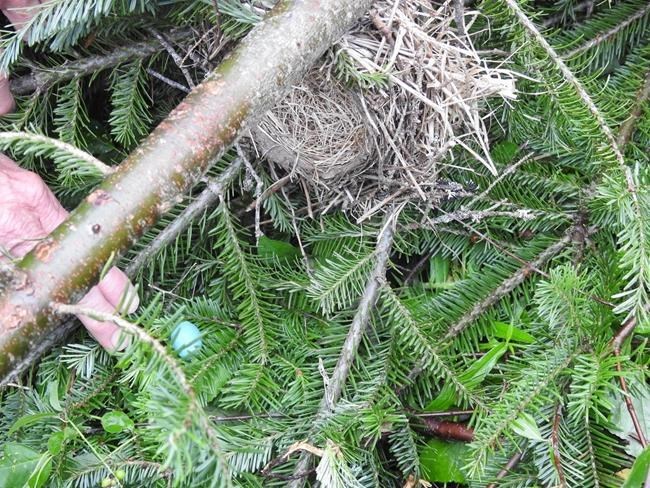
Landowners in Bear River, N.S., photographed the nest of an American robin, with three eggs spilled out, after contractors hired by Nova Scotia Power cut a 20-metre swath of trees and brush near the power lines on June 26. A Nova Scotia utility's destruction of a migratory bird nest as it carried out tree trimming is again raising the issue of how industry works in the province's forests during nesting seasons.THE CANADIAN PRESS/HO
Republished July 04, 2019 - 11:33 AM
Original Publication Date July 04, 2019 - 8:01 AM
A Nova Scotia utility's destruction of a migratory bird nest while clearing trees is again raising questions about the precautions industry should take in the province's forests during nesting seasons.
Landowners in Bear River, N.S., documented the downed nest of an American robin — with three eggs spilled out — after contractors hired by Nova Scotia Power cut a 20-metre swath of trees and brush near the power lines on June 26.
Cheryl and Jay Stone say the solution to the habitat destruction is for the utility to cut when the birds aren't reproducing and raising young.
"There's no point in doing it during the bird nesting time," Cheryl Stone, a 63-year-old artist and garden farmer, said in an interview.
"If they'd waited until the end of July or Aug. 1, there weren't any trees there that were going to cause problems anyway. They could have done it then and the birds would have been gone."
A similar viewpoint recently halted a logging operation 50 kilometres to the north, after nesting species of declining and endangered migratory birds were photographed and filmed by naturalists on a peninsula between Lake Dalhousie and Corbett Lake.
Nova Scotia Power spokesperson David Rodenhiser says nesting assessments are carried out by the contractor and the utility has protocols in place to have them create buffer zones around the nests during clearing.
But ending the cut during nesting season isn't an option at this time, he said.
"We have 32,000 kilometres of line in Nova Scotia to maintain. A high percentage would be through or bordering on forest. The reality is that in order to be able to provide reliable electrical service to Nova Scotians we have to have vegetation management throughout the year."
"We do our best to mitigate any adverse interaction with nesting bird species," he added, noting the utility has brought in a number of programs to preserve bird habitat.
However, the nest destruction in Bear River suggests protocols and precautions are falling short, says Scott Leslie, a naturalist and author of "Woodland Birds of North America."
It's almost certain that where one nest is destroyed, others that are harder to spot were also destroyed, he said during an interview from the community.
Leslie says having contractors attempt to spot nests won't suffice, as migratory birds carefully hide their homes, and even experienced wildlife biologists may fail to see them.
"The solution is just basically holding off (cutting) for a few weeks, or maybe a few months, during breeding season until the wildlife can produce its next generation and move on," he said, adding that exceptions should be made if trees pose imminent threat to the power lines.
The recent 2019 State of the Birds, assembled by Environment Canada, notes 43 species of forest birds — particularly the migratory species — are in decline.
"We're in a time when we need to up our game," said Leslie. "We are in an established crisis of biodiversity decline on the planet. ... It's definitely a time to start paying attention to these species."
The cases of nesting habitat destruction in southern Nova Scotia are also raising the issue of whether the Migratory Bird Convention Act should be enforced more strictly, he says.
Its provisions state it is illegal to disturb or destroy nests and eggs of migratory species — including those of the American robins, which move between Canada and the southern United States.
However, when industrial practices cause the destruction, fines and enforcement are rare, says Leslie.
Sheldon Jordan, head of Environment Canada’s wildlife enforcement, says legal activities such as forestry and power line trimming that may destroy nests are referred to by his agency as "incidental take."
This means there is no deliberate intention to cause the destruction, he said in a recent interview.
However, Jordan says his department has been shifting more attention to the "incidental take" of bird habitat by industries over the past decade, and is providing expertise, education and some enforcement.
"We are not going to stop industry from operating all year round, however we do expect that industry will comply with the law protecting migratory bird nests, particularly during nesting season," he said.
"It's clear the public also has some expectations around birds and their protection around this time of year."
Rodenhiser said the utility will learn from the incident.
"In this case the contractor did an assessment and missed the nest. We're disappointed by that. We're following up with the contractor and we regret that it happened," he said.
— Story by Michael Tutton in Halifax.
News from © The Canadian Press, 2019